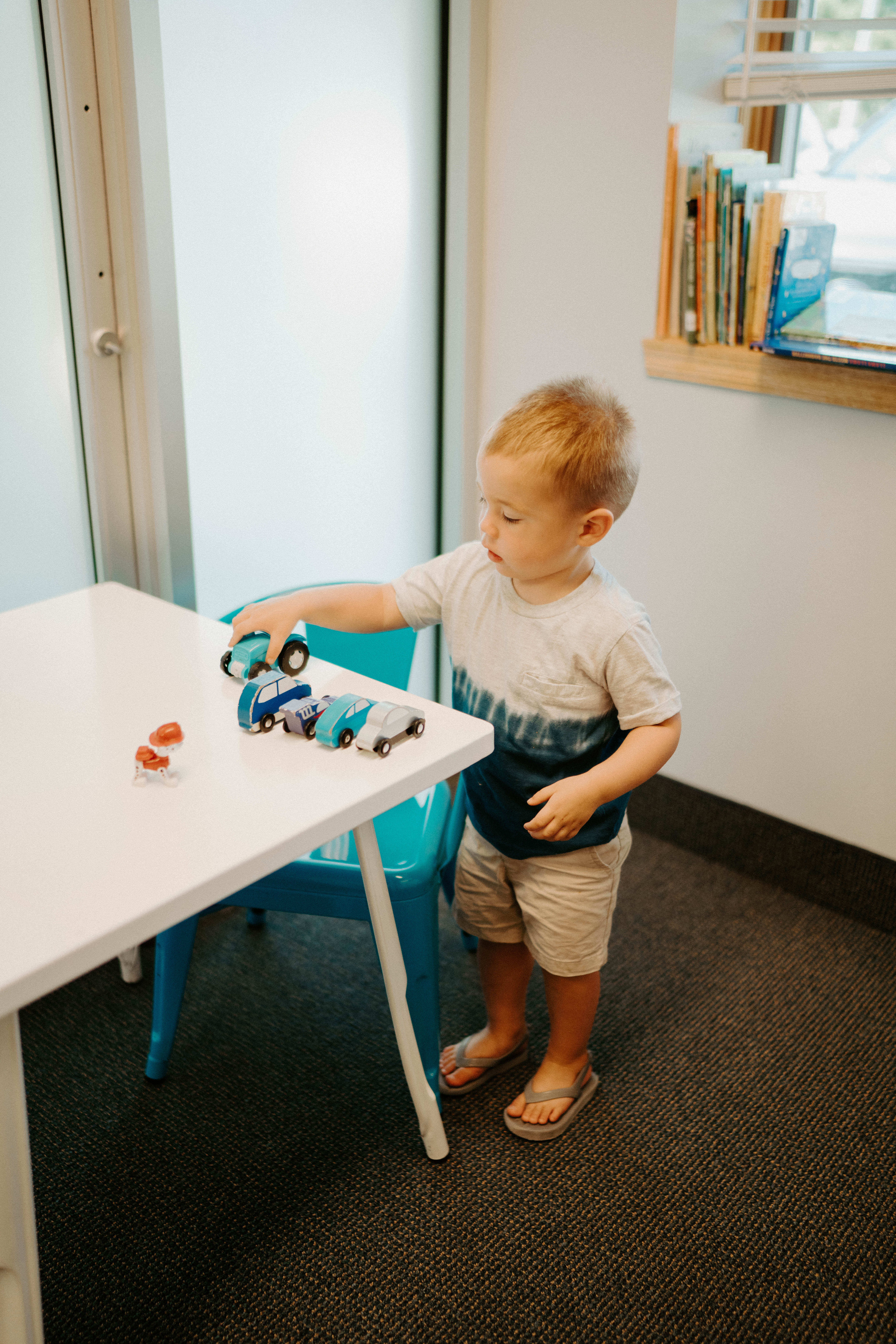WElcome TO
Explore our blog that focuses on holistic care for any and all ages - pediatric well-being, pre/post-natal health, and adult vitality.
THE BLOG

Motherhood is an excessive amount of responsibilities, from caring for our children to managing household chores, work commitments, and more. It often feels like there needs to be more hours in the day to accomplish everything on our to-do lists. With carpool lines, meal prepping, loads of laundry, and trying to keep all of the kids accounted for, it’s easy for moms to neglect their own well-being leading to exhaustion and burnout. Although motherhood is literally the best job in the world, it can also sometimes feel like the hardest, too. This season is full of joy, and it is very rewarding but can get lonely at times. This is why we created this little “survival guide” to help ease those tough days. To remind you to give yourself grace. That you are the best mother for your child. AND to give you some practical tips to help your overall health and wellbeing.
Understanding the Science
As mothers, our bodies undergo significant changes, both physically and mentally. Due to frequent hormonal changes, sympathetic overdrive, and exhaustion, we need to do all we can to support our bodies through motherhood. One key contributor to exhaustion is adrenal fatigue, a condition where the adrenal glands become overworked due to chronic stress. This constant state of heightened stress can lead to feelings of anxiety and overwhelm as our nervous system gets stuck in fight-or-flight mode.
Moreover, the lack of quality sleep exacerbates the problem, leaving us reliant on caffeine to get through the day. Unfortunately, coffee, energy drinks, and other caffeine only act as band-aids. Forcing us as moms to never get out of this cycle and help the root cause, which is helping our nervous system become more adaptable to all of this stress!
Tips for Survival
So, how can we navigate motherhood with resilience and adaptability? It starts with prioritizing self-care and making small but impactful changes to our daily routines. Here are some tips to help you thrive:
- Prioritize sleep: Aim for at least 7-8 hours of quality sleep each night by establishing a bedtime routine and creating a relaxing sleep environment.
- Fuel your body with nutritious foods: Focus on eating whole, nutrient-dense foods that nourish your body and provide sustained energy throughout the day. Start the day with protein first, even before coffee!
- Delegate tasks and ask for help: Don’t be afraid to ask for support from your partner, family members, or friends. Delegate tasks and responsibilities to lighten your load and give yourself time to recharge.
- Make time for self-care: Schedule regular self-care activities that rejuvenate your mind, body, and soul. Whether it’s taking a long bath, going for a walk in nature, or indulging in your favorite hobby. Prioritize activities that bring you joy and relaxation, even if it is just 10 minutes to reset!
Regulate Your Nervous System
This should be the first step! The above suggestions are very important, but most of them won’t make a major impact unless our nervous systems are rested and regulated FIRST. So what does this mean? First, let’s go over the two parts of our nervous system. The Parasympathetic Nervous System (the brake pedal) and the Sympathetic Nervous System (the gas pedal). Each part is equally important! The goal is to have fluidity between the two. If you need to be in go mode, chasing after your child, you want the gas pedal on! But once they start to calm down, your nervous system should be able to recognize this and enter a rested and relaxed state as well. Most of us as moms are stuck in sympathetic dominance. This means that even when our children are safe, our body is stuck in stress mode. When we are chronically stuck in this state, exhaustion really settles in, and motherhood challenges become physical fast.
Taking the First Step
If you’re struggling to find balance in motherhood, consider exploring neurologically-focused chiropractic care. By being on a care plan that is customized to your “mom exhaustion,” your nervous system will be able to find the balance between the gas vs brake. It will strive for resiliency and adaptability to all that comes with being an amazing mom!
So, how do you start?! Our cutting-edge technology, called the CLA INSiGHT Scan, assesses your nervous system’s function. It shows us exactly what is going on within your brain and body and can pinpoint that mom exhaustion! Take the first step towards a healthier, happier you by scheduling a nervous system scan today.
Success Story: Alyssa’s Journey
Let us tell you about our awesome friend, Alyssa, and we’ll look at one of her Neurological INSiGHT Scans.
About three months after giving birth, Alyssa threw out her back. She thought it would just resolve over time, but instead, the pain she was experiencing was not decreasing and, in fact, was increasing rapidly. Alyssa was at the point where she was barely able to move off the couch, let alone care for her newborn baby.
When she saw her scans, Alyssa was really shocked and immediately a little disappointed. She was expecting everything to be lit up like a red Christmas tree! But there wasn’t a lot lit up at all. She immediately felt hopeless and like she was “unhelpable.” BUT then we explained to her that her body was so exhausted from the pain and the neurological state of the “gas pedal” that it was in shutdown mode! The scan wasn’t lit up because it was exhausted!!
Surprisingly, pain relief wasn’t the first sign that Alyssa’s care plan was working. Instead, she noticed that she was finally able to sleep! She had always struggled with sleep and had never been able to fall asleep or stay asleep. She also noticed that her anxiety was no longer affecting her everyday life. AND finally her back pain began to diminish!
Here is Alyssa’s first EMG scan! The yellow in Alyssa’s neurological scans indicated exhaustion in her body after being stuck on sympathetic ‘stress mode’ for too long.
Alyssa’s life has looked different in many ways since starting. She is completely off all anxiety meds, has less and less pain every day, and has been able to achieve her initial goal – PLAY ON THE FLOOR WITH HER BABY. Alyssa said that she loves having a provider team that believes in her and feels more empowered to advocate for herself and her family.
Ready to see what your Neurological INSiGHT Scans look like?!
Motherhood is the most extraordinary club to be a part of, but it is also just straight-up HARD sometimes. We hope that we can help you find the hope, answers, and drug-free help that you have been searching for. For not only your sweet kiddos and family but FOR YOU too!

As an expecting parent, you’re likely surrounded by advice about baby registries, prenatal yoga classes, folate supplements, and which stroller to buy. While all these preparations are important and exciting, there’s something even more fundamental that deserves your attention first: your nervous system. In America, we’re often encouraged to focus on the material aspects of pregnancy preparation, but the health of your nervous system should be your #1 priority.
Why? Because your nervous system controls every cell, tissue, and organ in your body, it directly impacts your baby’s development, too.
Your Baby Feels Everything You Feel
Did you know that your baby’s nervous system begins developing just 3-4 weeks after conception? That’s often before many women even realize they’re pregnant! This early nervous system development sets the foundation for everything else—from organ development to immune system function.
But here’s what’s truly fascinating: the umbilical cord isn’t just delivering nutrients and oxygen to your baby. It’s essentially the power cord connecting your nervous systems. This means:
- When you experience stress, your body releases hormones that cross directly to your baby through the umbilical cord and placenta
- Your baby experiences everything you experience, from moments of calm to periods of stress
- Your emotional state directly influences your baby’s developing nervous system
Modern Life and Pregnancy Stress
Today’s pregnant mothers face more sustained, chronic stress than ever before. Between work demands, family responsibilities, financial pressures, and even the constant monitoring and testing of traditional prenatal care, it’s easy to become overwhelmed.
This sustained stress can shift both you and your baby into what we call “sympathetic dominance”—essentially a state of constant fight-or-flight. When your body stays in this stressed state, it can affect:
- Your sleep quality
- Your mood and emotional wellbeing
- Your physical comfort during pregnancy
- Your baby’s development
- Your birth experience
Gabriella’s Story: From Overwhelmed to Empowered
Let us share a story that might resonate with you. Gabriella came to our office around 30 weeks pregnant, initially because she had experienced some falls. Her scans showed what we often see—her nervous system was stuck in “fight or flight” mode, leaving her exhausted and overwhelmed.
“I instantly regretted not starting sooner,” Gabriella told us about beginning care. After getting her nervous system checked and starting a personalized care plan, she experienced dramatic improvements. Not only did her physical pain decrease, but her mood swings, anxiety, and energy levels changed significantly.
In her own words: “My anxiety, depression, brain fog, and back pain have improved so much… I wake up energized and ready to start my hectic days, when before I dragged my feet. Overall it has been such a blessing.”
Measuring and Understanding Your Nervous System
The good news is that we now have technology that can measure nervous system function. Heart Rate Variability (HRV) scans show us exactly how your nervous system is handling stress and where you might be stuck in fight-or-flight mode.
These non-invasive scans allow us to create personalized care plans specific to your needs and your baby’s development stage. Think of it as a window into how your body is handling the stress of pregnancy—and a roadmap for bringing things back into balance.
How Neurologically-Focused Chiropractic Care Helps
Specific adjustments can help activate your vagus nerve and parasympathetic nervous system—your body’s “rest and digest” mode. This helps shift your body out of stress mode and into a state of healing and optimal development.
Regular care helps maintain this balance throughout your pregnancy journey, providing benefits such as:
- Reduced physical discomfort
- Better sleep quality
- Decreased anxiety and mood swings
- More energy for daily activities
- Optimal conditions for your baby’s development
- Better preparation for labor and delivery
Your Pregnancy Doesn’t Have to Be Nine Months of Stress
Just like Gabriella discovered, pregnancy doesn’t have to be nine months of stress and anxiety. You have the power to transform your pregnancy experience and optimize your baby’s development through understanding and caring for your nervous system.
The first step is getting your nervous system checked with advanced HRV technology. This simple, non-invasive scan can tell us exactly what’s happening with your nervous system and help create a personalized care plan for you and your baby.
Don’t wait until you’re exhausted and overwhelmed like so many parents do. Imagine waking up with energy, feeling connected to your baby, and actually enjoying your pregnancy instead of just surviving it.
Remember what Gabriella said: “Never would have thought chiropractic care would make such a huge impact on me and my family’s lives.” Your transformation story can start today.
Taking the First Step
If you’re pregnant or planning to be in the future, don’t wait to reach out to RCW to schedule a consultation and Neurological INSiGHT Scan.
Your baby experiences everything you experience. By focusing on your nervous system health, you’re giving your baby the best possible start in life—beginning before they even take their first breath.

As a parent of a child with autism, you’ve likely found yourself wondering about those repetitive movements – the hand flapping, rocking, or specific sounds your child makes. Perhaps you’ve received well-meaning but misguided advice to suppress these behaviors or been told “they’ll grow out of it.”
Today, let’s explore the real root cause and deeper neurological story behind stimming that most healthcare providers miss, and how understanding it could transform your approach to supporting your child. Realizing how stimming connects to nervous system dysfunction reveals a powerful truth: addressing your child’s underlying sensory tension can help them and your whole family find relief.
The Hidden Purpose of Stimming
Let me share a story about a young girl who came to our clinic with repetitive nodding movements. Her mom noticed these movements would intensify when she felt stressed or anxious. Described how they seemed to help with the “butterflies in her stomach.” After unsuccessful medical interventions and facing the prospect of medication, her mother’s intuition told her there had to be another explanation.
Through advanced neurological scanning, called INSiGHT Scans, we discovered what many had missed – her nervous system was stuck in a state of stress and dysfunction, creating these movements as a vital self-regulation tool.
This discovery reflects a broader truth: stimming isn’t just a quirky behavior to eliminate – it’s your child’s nervous system attempting to find balance. Research shows that 80% of adults with autism report that stimming helps reduce their anxiety and provides essential calming effects. These movements serve as a coping mechanism for an overwhelmed nervous system stuck in nonstop sympathetic “fight or flight” mode.
The Science Behind the Movement
To truly understand stimming, we need to look at three key neurological factors:
- Autonomic Nervous System Imbalance: At the core of stimming lies a condition called dysautonomia. Where the sympathetic “fight or flight” system becomes overactive, while the parasympathetic “rest and digest” system is underactive. This imbalance leaves children stuck in a state of constant stress and sensory overload.
- Subluxation and Proprioception: A crucial piece of the puzzle involves something called subluxation. A combination of joint dysfunction and decreased proprioception (your body’s awareness of movement and position in space). When this system isn’t working optimally, it reduces the calming, regulating input your child’s brain needs. Stimming becomes their way of compensating for this deficit.
- Sensory Processing Connection: Subluxation, particularly in the upper cervical spine, can interfere with how the brain processes sensory information. This leads to sensory overload, prompting stimming as a self-soothing response. It’s your child’s creative solution to an overwhelming sensory world.
The Role of the Vagus Nerve
The vagus nerve plays a crucial role in this story. This important nerve helps activate the body’s “rest, regulate, and digest” functions. When it’s not functioning well due to nervous system stress, children can get stuck in fight-or-flight mode, leading to increased anxiety and repetitive behaviors.
A Natural Path Forward
While traditional approaches often focus on suppressing stimming, modern neuroscience shows us a better way. Through neurologically-focused care, we can:
- Regulate the Sensory Processing System: By addressing nervous system interference and restoring balance, we can help your child’s brain process sensory input more efficiently, naturally reducing the need for constant stimming.
- Support Emotional Regulation: When the nervous system is overwhelmed, children may struggle to manage emotions. Leading to increased stimming during moments of anxiety, frustration, or excitement. By addressing root causes, we can improve your child’s ability to self-regulate emotionally.
- Activate Natural Calming Responses: By supporting proper vagus nerve function, we can help activate your child’s natural calming responses. Reducing the constant state of fight-or-flight that often drives stimming behaviors.
While neurologically-focused chiropractic care isn’t aimed at eliminating stimming altogether, addressing the underlying nervous system stress can help reduce its frequency and intensity. Families often report that as their child’s nervous system becomes more regulated, they see improvements in:
- Sensory processing
- Emotional balance
- Overall quality of life
- Ability to engage in daily activities
- Communication and interaction
Moving Forward
Understanding stimming as a window into your child’s nervous system function can transform your approach to supporting their development. Rather than viewing it as a problem to fix, see it as valuable information – your child’s way of telling you their nervous system needs support. And we want to help!
Remember, every child’s journey is unique, but understanding these underlying neurological factors helps you become better equipped to make informed choices about supporting your child’s development and well-being. Your child’s stimming isn’t random – it’s purposeful. By addressing the root causes, we can help your child find better balance and thrive in their own unique way.






